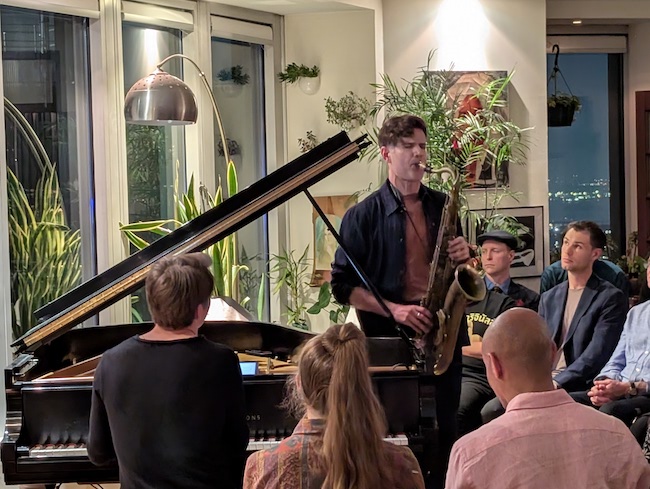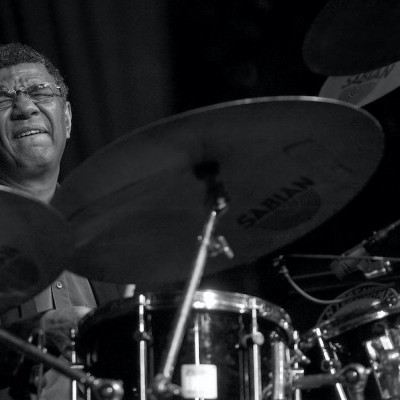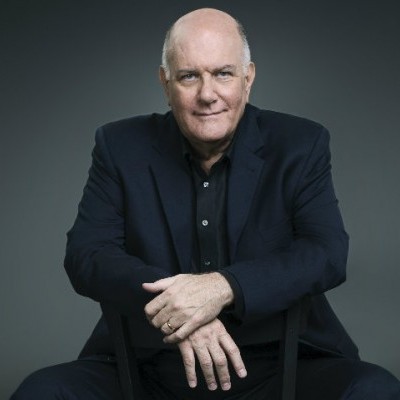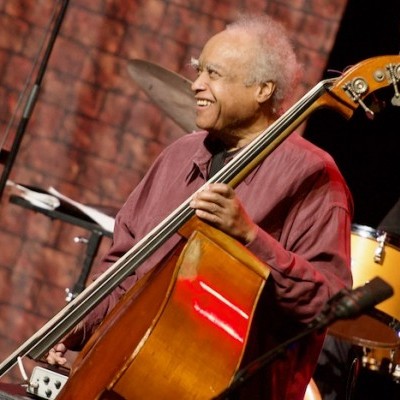Oct 28, 2025 10:47 AM
In Memoriam: Jack DeJohnette, 1942–2025
Jack DeJohnette, a bold and resourceful drummer and NEA Jazz Master who forged a unique vocabulary on the kit over his…

“I like to think of composition, especially in jazz, as setting up a system of constraints and finding the freedom within those constraints,” said pianist Dan Tepfer, shown here with saxophonist Ben Wendel.
(Photo: Lora Aroyo)On the night of May 16, Dan Tepfer found himself working on the 68th floor of an apartment tower directly across the street from Carnegie Hall. The job was a house concert, for which the pianist had revived a duo with an old friend, saxophonist Ben Wendel.
Come November, the 43-year-old Tepfer will make the jump to Carnegie in a debut that will bring to its underground space, Zankel Hall, an updated version of his Natural Machines project. The update will involve a complex new digital setup that allows him to “play” an orchestra in real time — a vastly expanded affair whose prospect might seem to bear little relationship to the more-modest, all-acoustic house concert.
But as it turned out, the house concert was of a piece with even the highest-concept items in Tepfer’s portfolio. The concert proved an apt platform for the features of his writing process that hold irrespective of the scale at which, or the materials with which, he is working. Prime among those constants, he said, is a predilection for composing “from the level of idea.”
“I like to think of composition, especially in jazz,” he explained in a post-concert debriefing, “as setting up a system of constraints and finding the freedom within those constraints.”
At the house concert, constraints were perhaps most clearly defined in the melodic framework of the evening’s one premiere, the buoyant “Lora Aroyo.” The title is the concert sponsor’s name. From it, Tepfer fashioned a melody that used a system for converting the alphabet into notes. The letter A equated to the note C, B to C-sharp and so forth, the notes rising chromatically with each succeeding letter of the alphabet. While the conversion system was arbitrary, it yielded a melody unique to Aroyo — one that pleased Tepfer.
Declaring the melody “quite a nice” one, he gamely sang a few bars of it. And indeed it was devoid of awkward leaps or tortured twists and turns. Consisting of all white-key notes, it seemed to reflect a logic in its organization of pitches that belied the method of its creation. “It’s amazing, actually, because I’ve done this for other people and you usually get something pretty weird, something really chromatic, and you have to kind of massage it to make it work.”
The other constraint he imposed on the tune’s creation was a matter of meter. Aroyo hails from Bulgaria, where folk dances in odd time signatures are core to the culture. One such dance is the rachenitsa. It’s in 7/8, and that became the base over which he laid the melody, which in turn became the starting point for an ebullient joint improvisation that found no shortage of freedom within the constraints — capturing, in the process, the spirit of the host.
Like “Lora Aroyo,” Tepfer’s “Internal Melodies” was also subject to creative constraints. Its writing grew out of a progression of four-note chords each of whose voices, he discovered, had a pleasing line of its own. “I wanted to excavate them, one by one,” he said, noting that the saxophone plays each line — bass, tenor, alto and soprano — one after another. In Wendel’s reading, the resulting melody sounded effortlessly arrived at — a testament to his interpretive skill, though it didn’t hurt that, unlike the melodic material in “Lora Aroyo,” the notes were related musically from the get-go.
Dealing adroitly with voices both independent and interlocking is very much in Tepfer’s wheelhouse. As much as any jazz musician on the scene, he has authentically mined the means and methods of Baroque counterpoint, not least in solo takes (and takeoffs) on Bach like Goldberg Variations/Variations (2011) and Inventions/Reinventions (2023). But the addition of a bandstand partner will inevitably alter any outcome, and Tepfer’s saxophone-playing partners on “Internal Melodies” — Wendel and Miguel Zenón, who appeared with Tepfer on the 2023 duo album Internal Melodies and performed with him on other occasions — differed in approach.
By dint of both his instrument choice (alto) and sensibility, Zenón’s touch seemed lighter and more chamber-like, though Wendel displayed a subtle sensitivity to the tune’s demands that tempered his hard-driving tenor tendencies. Tepfer, whose duo skills gained wide notice in a working relationship with the late altoist Lee Konitz, exploited in full the capabilities of Zenón and Wendel without sublimating his identity in the least.
“Both aesthetics are great,” he said.
With all his emphasis on structure and rigor — Tepfer, who holds a degree in astrophysics, creates his own digital tools — he is sometimes seen as being driven by the science. But he does not see himself that way. By his own account, his aesthetic lies “at the intersection of the algorithmic and spiritual.” He adheres strictly, he said, to neither “overdetermined systems” nor the “purely spiritual or intuitive.”
“In the middle you have people like Bach or Coltrane who are in both systems simultaneously,” he explained. “In my opinion, that’s where the strongest music comes from.”
Tepfer said that his willingness to talk about the science might factor into some people’s misperceptions of him. But if anyone doubted the depth of his heart, all he had to hear was the house concert’s moving opening number, “Where Do We Go From Here?”
Though written during the pandemic, it seemed far from the expression of existential dread its title might suggest. Rather, it emerged as a remembrance of both Tepfer’s mother, who died in a 2019 car crash, and a period when the elasticity of time seemed to challenge the possibility of untimely death for space in the collective consciousness.
Written in part to satisfy a pandemic-era livestream audience eager for new material, the piece also seemed a meditation on the notion of time conceived as a finite unit against which we measure our ability to create something lasting. Its creation’s sole constraint was the 45 minutes Tepfer, using Fred Hersch’s kitchen-timer formulation, allotted for its completion.
He achieved his goal within that framework — an achievement that, paired with his ability to freely improvise within it, owed much to “the miracle of jazz,” he said, “because what’s on the page can signify more than what’s there.” DB

Jack DeJohnette boasted a musical resume that was as long as it was fearsome.
Oct 28, 2025 10:47 AM
Jack DeJohnette, a bold and resourceful drummer and NEA Jazz Master who forged a unique vocabulary on the kit over his…

D’Angelo achieved commercial and critical success experimenting with a fusion of jazz, funk, soul, R&B and hip-hop.
Oct 14, 2025 1:47 PM
D’Angelo, a Grammy-winning R&B and neo-soul singer, guitarist and pianist who exerted a profound influence on 21st…

Kandace Springs channeled Shirley Horn’s deliberate phrasing and sublime self-accompaniment during her set at this year’s Pittsburgh International Jazz Festival.
Sep 30, 2025 12:28 PM
Janis Burley, the Pittsburgh International Jazz Festival’s founder and artistic director, did not, as might be…

Jim McNeely’s singular body of work had a profound and lasting influence on many of today’s top jazz composers in the U.S. and in Europe.
Oct 7, 2025 3:40 PM
Pianist Jim McNeely, one of the most distinguished large ensemble jazz composers of his generation, died Sept. 26 at…

Drummond was cherished by generations of mainstream jazz listeners and bandleaders for his authoritative tonal presence, a defining quality of his style most apparent when he played his instrument unamplified.
Nov 4, 2025 11:39 AM
Ray Drummond, a first-call bassist who appeared on hundreds of albums as a sideman for some of the top names in jazz…